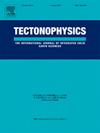Extension rate variations across the South Tibetan rifts – New data from the northern Xainza-Dinggye Graben
IF 2.6
3区 地球科学
Q2 GEOCHEMISTRY & GEOPHYSICS
引用次数: 0
Abstract
The active ∼NS-trending rifts in southern Tibet reflect ongoing ∼EW extension alongside ∼NS shortening from the India-Asia collision. Quantifying late Quaternary extension rates is essential to comprehend Tibetan deformation and evolution. Here, we test whether extension rates across the Xainza-Dinggye rift (XDR) are on the same order as those along the Yadong-Gulu rift (YGR), and whether a similar northward increase in extension rate exists along the XDR due to interaction with the dextral Gyaring Co fault to its north as exists along the YGR due to interaction with the dextral Beng Co fault to the north, where rates increase from 0.8 to 1.3 to 3–6 mm/yr from south to north. We use 10Be cosmogenic dating and topographic surveying at three sites along the northernmost XDR, where geomorphic surfaces are vertically offset by several normal faults bounding the western side of the graben. Our results suggest extension rates <1 mm/yr, i.e., much smaller than those across the YGR, except where surfaces are younger than the Last Glacial Maximum (LGM). This suggests a post-LGM rate acceleration following glacier melting and post-glacial rebound due to fault unloading. Therefore, we may need to reconsider the previous assumption of a constant extension rate of 1.3 mm/yr across each of the seven main rifts yielding a total extension rate of 9 ± 2 mm/yr across southern Tibet. We infer that only the larger and more continuous rifts may absorb significant horizontal extension, compared to smaller rifts which may absorb less. Importantly, that extension rates do not increase northwards along the XDR may be due to its particular orientation perpendicular to the Main Frontal Thrust (MFT), compared to other rifts that are more oblique to it. This reinforces earlier inferences that the rifts are related to divergent, orthogonal thrusting along the curved Himalayan MFT.
青藏高原南部断陷的伸展速率变化——新扎-定界地堑北部的新资料
西藏南部活跃的~ NS向裂谷反映了印度-亚洲碰撞引起的~ NS缩短和持续的~ EW延伸。量化晚第四纪伸展速率对理解西藏的变形和演化具有重要意义。在此,我们测试了新扎-定界裂谷(XDR)的伸展速率是否与沿亚东-古鲁裂谷(YGR)的伸展速率相同,以及XDR沿其北部与右旋嘉陵公司断裂的相互作用是否存在与沿YGR沿其北部与右旋benco断裂的相互作用相似的北拉速率增加,速率从南到北从0.8增加到1.3到3-6 mm/yr。我们在XDR最北端的三个地点使用了10Be宇宙测年和地形测量,这些地点的地貌表面被几条包围着地堑西侧的正断层垂直偏移。我们的结果表明,除了地表比末次极盛期(LGM)更年轻之外,地表的扩展速率为1 mm/yr,即远小于整个YGR的扩展速率。这表明冰川融化和断层卸荷导致的冰川回弹后lgm速率加速。因此,我们可能需要重新考虑先前的假设,即在七个主要裂谷中,每一个裂谷的延伸速率为1.3 mm/年,从而在藏南的总延伸速率为9±2 mm/年。我们推断,只有较大和较连续的裂谷才能吸收显著的水平伸展,而较小的裂谷吸收较少。重要的是,与其他更斜向的裂谷相比,XDR向北的延伸率没有增加,这可能是由于其垂直于主锋面逆冲(MFT)的特定方向。这加强了先前的推断,即裂缝与沿着弯曲的喜马拉雅MFT的发散的、正交的逆冲有关。
本文章由计算机程序翻译,如有差异,请以英文原文为准。
求助全文
约1分钟内获得全文
求助全文
来源期刊

Tectonophysics
地学-地球化学与地球物理
CiteScore
4.90
自引率
6.90%
发文量
300
审稿时长
6 months
期刊介绍:
The prime focus of Tectonophysics will be high-impact original research and reviews in the fields of kinematics, structure, composition, and dynamics of the solid arth at all scales. Tectonophysics particularly encourages submission of papers based on the integration of a multitude of geophysical, geological, geochemical, geodynamic, and geotectonic methods
 求助内容:
求助内容: 应助结果提醒方式:
应助结果提醒方式:


